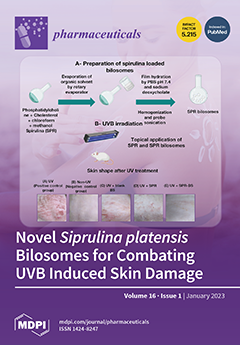Pharmaceuticals, Volume 16, Issue 1 (January 2023) – 133 articles
Nanosystems such as liposomes, ethosomes, transferosomes, and bilosomes (BS) have shown promising results in dermal drug delivery. Nonetheless, despite the interest of the cosmetic market in naturally derived skin care products, the promising potential of marine-derived natural products as a source for active compounds with antiaging effects has remained relatively undiscovered until recently.
Heretofore, a few studies have aimed to study and demonstrate the effect of a nano-platform incorporating SPR. To our knowledge, there have been no reports for SPR nanoformulation effects on ultraviolet B-mediated skin aging. Thus, the aim of this study is to develop a novel topically applied antiaging nanodelivery system encapsulating SPR, followed by in vitro and in vivo assessment to confirm the superior efficacy of this novel nanoplatform. View this paper
- Issues are regarded as officially published after their release is announced to the table of contents alert mailing list.
- You may sign up for e-mail alerts to receive table of contents of newly released issues.
- PDF is the official format for papers published in both, html and pdf forms. To view the papers in pdf format, click on the "PDF Full-text" link, and use the free Adobe Reader to open them.






